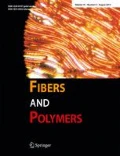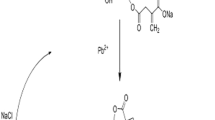Abstract
The influence of the chemical composition on the biosorption potential of waste jute fabric for Ni2+, Cu2+, and Zn2+ was investigated. The raw jute fabric was treated with sodium hydroxide or sodium chlorite to selectively remove hemicelluloses and lignin, respectively. All jute fabrics were characterized by determination of their chemical composition as well as functional group content. The effects of solution pH, contact time, and initial metal ion concentration on the biosorption from monometallic and polymetallic solution by jute fabrics were investigated. The maximum biosorption capacity for all heavy metal ions was observed at pH 5.5. Concerning the contact time, the raw jute fabric shows more than 72 % of the total uptake capacity of Ni2+, Cu2+, and Zn2+ within 1 h, while the jute fabrics with lower hemicelluloses and lignin content show between 72–85 % of the total uptake capacity within 3 h. Increased initial metal ion concentration from 10 to 20 mg/l in monometallic solution caused an increase in the total uptake capacity of jute fabrics with lower hemicelluloses and lignin content for 47–69 % (Ni2+), 42–63 % (Cu2+), and 22–37 % (Zn2+). The biosorption capacity of alkali treated jute fabrics was affected by the changes in the total amount of carboxyl and aldehyde groups that accompany the hemicelluloses removal. In the case of the oxidative treatment, the biosorption capacity was affected by the lignin content as well as the amount of introduced carboxyl groups. The best biosorption performance possesses jute fabric with 63.2 % lower lignin content as well as 81.1 % higher amount of carboxyl groups; biosorption capacity toward Ni2+, Cu2+, and Zn2+ in monometallic solution is about 2.4; 2.2 and 3.5 times higher compared to the raw jute fabric, respectively. All jute fabrics exhibited the same affinity order (which is independent on the initial metal ion concentrations) toward heavy metal ions: Ni2+ > Cu2+ > Zn2+ in the case of competitive biosorption. An increase in the initial metal ion concentration for two times in the polymetallic solution caused about a 35–59 % increase in the total uptake capacity of Ni2+, while the total uptake capacities of Cu2+ and Zn2+ increased for 19–38 % and 18–65 %, respectively.
Similar content being viewed by others
References
G. Crini, E. Lichtfouse, L. D. Wilson, and N. Morin-Crini, Environ. Chem. Lett., 17, 195 (2019).
M. Vukcevic, B. Pejic, M. Lausevic, I. Pajic-Lijakovic, and M. Kostic, Fiber. Polym., 15, 687 (2014).
A. B. Albadari, A. H. Al-Muhtasebb, N. A. Al-laqtaha, G. M. Walkera, S. J. Allena, and M. N. M. Ahmad, Chem. Eng. J., 169, 20 (2011).
S. Loiacono, G. Crini, G. Chanet, M. Raschetti, V. Placet, and N. Morin-Crini, J. Chem. Technol. Biotechnol., 96, 2596 (2018).
N. Kim, M. Park, and D. Park, Bioresour. Technol., 175, 629 (2015).
V. S. Trana, H. H. Ngo, W. Guo, J. Zhang, S. Liang, C. Ton-That, and X. Zhang, Bioresour. Technol., 182, 353 (2015).
B. Abbara, A. Alem, S. Marcotte, A. Panteta, N. D. Ahfir, L. Bizeta, and D. Duriattic, Process Saf. Environ. Prot., 109, 639 (2017).
W. N. L. dos Santos, D. D. Cavalcante, E. G. P. da Silva, C. F. das Virgens, and F. de Souza Dias, Microchem. J., 97, 269 (2011).
C. M. Hasfalina, R. Z. Maryam, C. A. Luqman, and M. Rashid, APCBEE Procedia, 3, 255 (2012).
M. O. Borna, M. Pirsaheb, M. V. Niri, R. K. Mashizie, B. Kakavandi, M. R. Zare, and A. Asadi, J. Taiwan. Inst. Chem. Eng., 68, 80 (2016).
M. R. Razak, N. A. Jusof, M. J. Haron, N. Ibrahim, F. Mohhamed, S. Kamaruzaman, and H. A. Al-Lohedan, Int. J. Biol. Macromol., 112, 754 (2018).
X. Peng, S. Su, M. Xia, K. Lou, F. Yang, S. Peng, and Y. Cia, Cellulose, 25, 1921 (2018).
S. Xu, X. Gong, H. Zou, C. Liu, C. Chen, and X. Zeng, J. Chin. Chem. Soc. Taipei, 62, 1072 (2015).
M. Kostic, B. Pejic, and M. Vukcevic in “Chemistry of lignocellulosic: Current Trends”, 1st ed. (T. Stefanovic Ed.), pp.3–21, CRC Press, Boca Raton, 2018.
L. Tofan, C. Paduraru, C. Teodosiu, and O. Toma, Cellul. Chem. Technol., 49, 219 (2015).
S. Loiacono, G. Crini, B. Martel, G. Chanet, C. Cosentino, M. Raschetti, V. Placet, G. Torri, and N. Morin-Crini, J. Appl. Polym. Sci., 134, 45138 (2017).
S. Loiacono, N. Morin-Crini, C. Cosentino, G. Torri, G. Chanet, P. Winterton, and G. Crini, J. Appl. Polym. Sci., 134, 44422 (2017).
J. Bugnet, N. Morin-Crini, C. Cosentino, G. Chanet, P. Winterton, and G. Crini, Environ. Eng. Manage. J., 16, 535 (2017).
G. Z. Kyzas, Z. Terzopoulou, V. Nikolaidis, E. Alexopoulou, and D. N. Bikiaris, J. Mol. Liq., 209, 209 (2015).
S. R. Shukla and R. S. Pai, Bioresour. Technol., 96, 1430 (2005).
Q. Huang, D. Hu, M. Chen, C. Bao, and X. Jin, J. Mol. Liq., 285, 288 (2019).
M. S. Hassan and M. H. Zohdy, J. Vinyl Add.. Tech., 24, 339 (2018).
M. S. Hassan and M. H. Zohdy, J. Nat. Fibers, 15, 506 (2018).
Z. Du, T. Zheng, P. Wang, L. Hao, and Y. Wang, Bioresour. Technol., 21, 41 (2016).
K. B. Krishnan, I. Doraiswamy, and K. P. Chellamani in “Bast and other Plant Fibers”, 1st ed. (R. R. Franck Ed.), pp.24–94, Woodhead Publishing Limited and CRC Press LCR, Cambridge, 2005.
A. Ivanovska, D. Cerovic, S. Maletic, I. Jankovic Castvan, K. Asanovic, and M. Kostic, Cellulose, 26, 5133 (2019).
J. Pérez, J. Muñoz-Dorado, T. de la Rubia, and J. Martínez, Int. Microbiol., 5, 53 (2002).
M. Kostic, B. Pejic, and P. Skundric, Bioresour. Technol., 99, 94 (2008).
A. Koblyakov, “Laboratory Practice in the Study of Textile Materials”, 1st ed., pp.192–200, Mir Publishers, Moscow, 1989.
W. Garner, “Textile Laboratory Manual”, 1st ed., pp.52–113, Heywood Books, London, 1967.
J. Praskalo, M. Kostic, A. Potthast, G. Popova, B. Pejic, and P. Skundric, Carbohydr. Polym., 77, 791 (2009).
B. D. Lazic, S. D. Janjic, T. Rijavec, and M. M. Kostic, J. Serb. Chem. Soc., 82, 83 (2017).
P. K. Ganguly and S. Chanda, Indian J. Fiber. Text. Res., 19, 38 (1994).
A. A. Nada and M. L. Hassan, J. Appl. Polym. Sci., 102, 1399 (2006).
B. Pejic, M. Vukcevic, M. Kostic, and P. Skundric, J. Hazard. Mater., 164, 46 (2009).
D. Ray and B. K. Sarkar, J. Appl. Polym. Sci., 80, 1013 (2001).
B. Pejic, M. Vukcevic, I. Pajic-Lijakovic, M. Lausevic, and M. Kostic, Chem. Eng. J., 172, 354 (2011).
M. Balintova, M. Holub, N. Stevulova, J. Cigasova, and M. Tesarcikova, Chem. Eng. Transac., 39, 625 (2014).
J. He, T. Kunitake, and A. Nakao, Chem. Mater., 15, 4401 (2003).
T. Saito and A. Isogai, Carbohydr. Polym., 61, 183 (2005).
B. D. Lazić, B. M. Pejić, A. D. Kramar, M. M. Vukčević, K. R. Mihajlovski, R. D. Rusmirović, and M. M. Kostić, Cellulose, 25, 697 (2018).
S. Ifuku, M. Tsuji, M. Morimoto, H. Saimoto, and H. Yano, Biomacromolecules, 10, 2714 (2009).
M. Schwanninger, J. C. Rodrigues, H. Pereira, and B. Hinterstoisser, Vib. Spectrosc., 36, 23 (2004).
M. K. B. Bakri, E. Jayamani, S. Hamdan S, Md. R. Rahman, and K. H. Soon, J. Eng. Appl. Sci., 11, 8759 (2016).
L. Y. Mwaikambo and M. P. Ansell, J. Appl. Polym. Sci., 84, 2222 (2002).
H. Zhang H, R. Ming, G. Yang, Y. Li, Q. Li, and H. Shao, Polym. Eng. Sci., 55, 2553 (2015).
D. Ahuja, A. Kaushik, and G. S. Chauha, Int. J. Biol. Macromol., 97, 403 (2017).
S. K. Saw, R. Purwar, S. Nandy, J. Ghose, and G. Sarkhel, Bioresources, 8, 4805 (2013).
Acknowledgment
This work was supported by the Ministry of Education, Science and Technological Development of the Government of the Republic of Serbia (project OI 172029).
Author information
Authors and Affiliations
Corresponding author
Supplementary material
Rights and permissions
About this article
Cite this article
Ivanovska, A., Dojcinovic, B., Maletic, S. et al. Waste Jute Fabric as a Biosorbent for Heavy Metal Ions from Aqueous Solution. Fibers Polym 21, 1992–2002 (2020). https://doi.org/10.1007/s12221-020-9639-8
Received:
Revised:
Accepted:
Published:
Issue Date:
DOI: https://doi.org/10.1007/s12221-020-9639-8




